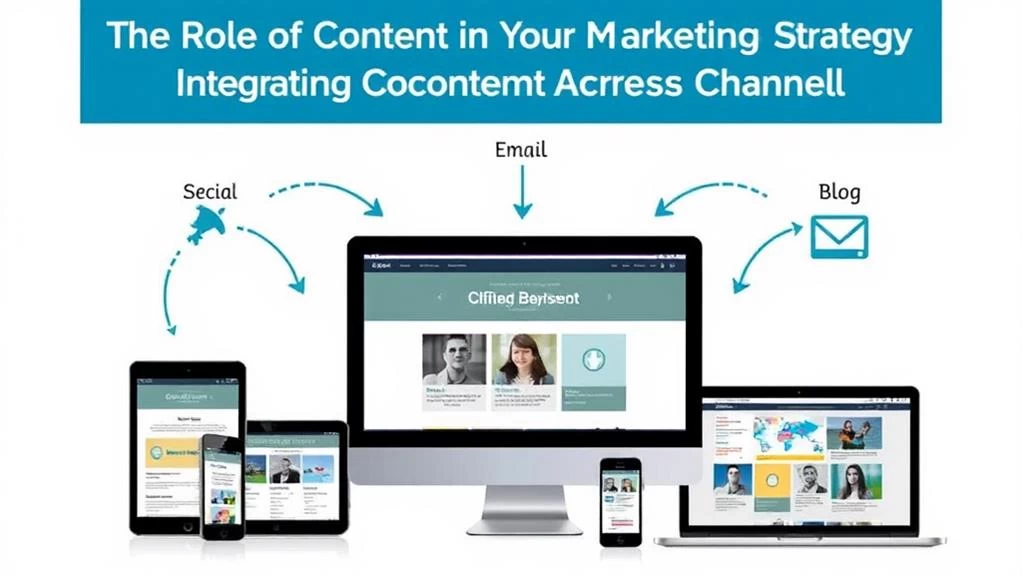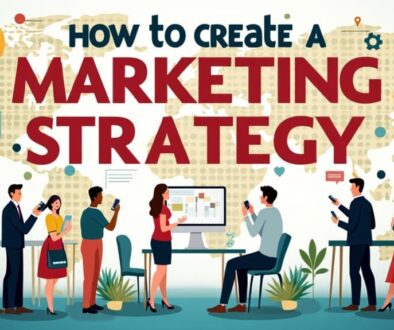The Role of Content in Your Marketing Strategy
Content plays a crucial role in marketing, serving as the nexus between brands and their audiences. It not only enhances visibility but also drives engagement and conversion rates, with data showing brands focusing on content marketing achieving up to six times higher conversions. Effective content types, including blog posts, videos, and infographics, cater to audience preferences while fostering a two-way dialogue. Best practices like SEO optimization and user-generated content promote trust and community ties. Ultimately, a well-integrated content strategy across channels amplifies brand identity. Discover how to maximize content's impact on your marketing approach.
Key Takeaways
- Content marketing increases brand visibility and drives engagement, making it a crucial element of your overall marketing strategy.
- Tailored content improves conversion rates, allowing brands to connect more effectively with their target audience.
- Engaging content fosters two-way dialogue, enhancing community ties and brand narratives through audience feedback.
- Measuring content performance through analytics helps refine strategies and align with audience preferences.
- Integrating content across various channels ensures consistent messaging and a seamless experience for the audience.
Understanding Content's Importance

In today's digital landscape, where consumers are bombarded with information at every turn, understanding the importance of content in your marketing strategy is essential. Content marketing has evolved into a crucial component for brands seeking to connect with their audience meaningfully. It serves not only as a vehicle for storytelling but as a strategic tool that enhances brand visibility and drives audience engagement.
The data is compelling: brands that prioritize content marketing see conversion rates up to six times higher than those that do not. This correlation underscores the necessity of delivering high-quality, relevant content that resonates with your target demographic. Consequently, developing an audience-centric approach is critical; understanding the preferences and pain points of your audience allows you to craft tailored messages that foster a sense of connection and loyalty.
Moreover, engaging content helps facilitate a two-way dialogue, enabling customers to share feedback and insights. This open line of communication empowers consumers, granting them the freedom to express their opinions, which, in turn, enriches your brand narrative and strengthens community ties.
Types of Effective Content
Effective content comes in various forms, each playing a distinct role in driving engagement and conversion. Understanding the types of effective content can empower marketers to develop a strategy that resonates with audiences seeking freedom and empowerment in their choices.
Blog posts are a staple, providing valuable insights and fostering conversations around subjects that matter to your audience. Complementing these are video tutorials, which bring concepts to life through visual learning, offering a more dynamic and memorable experience.
Infographic design serves to simplify complex information, presenting data in a visually appealing way that encourages sharing and engagement. Social media posts are essential for maintaining active communication with your audience, allowing for real-time interaction and brand presence in everyday conversations.
In addition, podcasts series cater to the on-the-go consumer, offering insights and stories that foster community and connection. Email newsletters are a highly effective way to deliver curated content directly to interested parties, enhancing loyalty and delivering personalized value.
Case studies illustrate success narratives, building trust through real-life examples, while white papers provide in-depth analysis on industry trends, establishing authority and expertise.
Content Creation Best Practices

While a strong content strategy may encompass various formats, the best practices for content creation remain fundamental to achieving engagement and conversion.
To foster meaningful audience engagement, it is essential to adhere to principles that resonate consistently with your brand's voice. This involves not only crafting compelling narratives through storytelling techniques but also strategically implementing SEO optimization to enhance visibility.
Consider integrating these best practices into your content creation process:
- Establish a content calendar: Planning your posts and themes enhances organization and maintains brand consistency.
- Embrace visual content: Infographics, videos, and images are powerful tools for engaging your audience and can greatly boost interaction.
- Leverage user-generated content: Encourage your audience to contribute by sharing their experiences, amplifying trust and community connection.
- Implement content repurposing: Extend the life of your content by transforming blogs into videos or infographics, ensuring your message reaches diverse platforms.
Measuring Content Performance
Analyzing the impact of your content is essential for refining your marketing strategy and driving results. To optimize your efforts, embracing content analytics allows you to explore deep into performance metrics, revealing not only what resonates with your audience but also where improvements can be made.
Key performance indicators such as audience engagement and conversion rates serve as invaluable benchmarks for evaluating content effectiveness.
Data-driven insights are vital for uncovering trends and patterns within your content performance. For instance, by implementing A/B testing, you can compare variations of your content to identify which elements captivate your audience and convert more effectively.
This continuous experimentation fosters a culture of innovation, ensuring that your content remains relevant and aligned with your audience's desires for freedom and authenticity.
Gathering user feedback is another integral facet of measuring content performance. Surveys and comment sections can provide qualitative data that complements the quantitative insights from analytics.
Understanding how your audience perceives your content allows you to craft narratives that truly connect with their needs and aspirations.
Integrating Content Across Channels

A cohesive approach to content integration across channels is essential for maximizing reach and engagement. By ensuring cross-channel consistency, brands can create a seamless experience that resonates with their target audience.
To achieve this, it is crucial to recognize the distinct characteristics and preferences of various channels while maintaining a unified brand voice.
Effective audience segmentation serves as the foundation for tailoring content that speaks directly to specific demographics. This targeted approach encourages deeper connections and fosters higher engagement rates.
Consider the following strategies for integrating content across channels:
- Consistent Messaging: Align your core messages to reflect similar themes regardless of the platform, reinforcing brand identity.
- Customized Formats: Adapt content types (blogs, videos, infographics) to leverage each channel's strengths, enhancing user engagement.
- Cross-Promotion: Use each channel to promote content on others, creating a network of interconnected touchpoints that drive traffic.
- Data-Driven Insights: Utilize analytics to refine your cross-channel strategies, ensuring content meets the evolving needs and preferences of your audience.
Integrating content effectively not only amplifies your reach but also cultivates a loyal community of followers who feel understood and valued.
Frequently Asked Questions
How Often Should I Update Existing Content?
Updating existing content is essential for maintaining content freshness and enhancing audience engagement.
As a strategic approach, it is advisable to review and refresh content at least every six months, or more frequently if the subject matter evolves. Incorporating recent data, trends, and audience feedback can greatly improve relevance and interest.
Regular updates not only bolster SEO performance but also reaffirm your brand's commitment to providing valuable, up-to-date information that resonates with your audience.
Can I Repurpose Content for Different Platforms?
Absolutely, repurposing content for different platforms is a strategic approach that enhances reach and engagement.
By leveraging cross-platform strategies, one can maximize the value of existing content, ensuring it resonates with diverse audiences.
Content format adaptability is essential; transforming a blog post into a video or infographic allows for tailored messaging suited to each platform's unique characteristics.
This not only saves resources but also fosters a sense of freedom in creative expression and audience connection.
What Types of Content Drive the Most Traffic?
In the expansive realm of content, certain forms serve as guiding stars, illuminating pathways to increased traffic.
Infographics create visual impact, facilitating quicker comprehension. Video engagement captivates audiences, fostering deeper connections.
Additionally, user-generated content amplifies authenticity, while social sharing enhances visibility. Seasonal trends can capitalize on timing, catering to audience preferences.
Together, these diverse elements forge a dynamic content strategy, ensuring a robust influx of traffic while embracing the freedom of creativity.
How Does Content Affect SEO Rankings?
Content greatly influences SEO rankings through keyword optimization and content relevance. High-quality content, strategically crafted around targeted keywords, enhances visibility in search engine results.
Search engines prioritize content that answers users' queries effectively, thereby establishing authority and relevance. Additionally, engaging, informative content increases dwell time and reduces bounce rates, which are crucial metrics for SEO performance.
Ultimately, well-optimized content not only drives traffic but also supports long-term organic growth and visibility.
What Is the Optimal Length for Blog Posts?
In the extensive realm of digital communication, the ideal word count for blog posts often resembles a golden thread, seamlessly weaving reader engagement with impactful content.
Data suggests that posts averaging 1,500 to 2,500 words tend to attract and retain a captivated audience.
While the exact length may vary by context, consistently delivering value and insights will guarantee that your message resonates, allowing readers to experience the freedom of informed exploration.
Conclusion
The integration of content within a marketing strategy serves as the backbone of effective communication, guiding messages that resonate with target audiences. With diverse formats that cater to various consumer preferences, strategic content creation emerges as an art form grounded in data-driven insights. Continuous measurement of content performance guarantees alignment with business goals, transforming analytics into actionable strategies. Ultimately, a harmonized approach across channels elevates brand narratives, fostering engagement and facilitating lasting connections with consumers.




